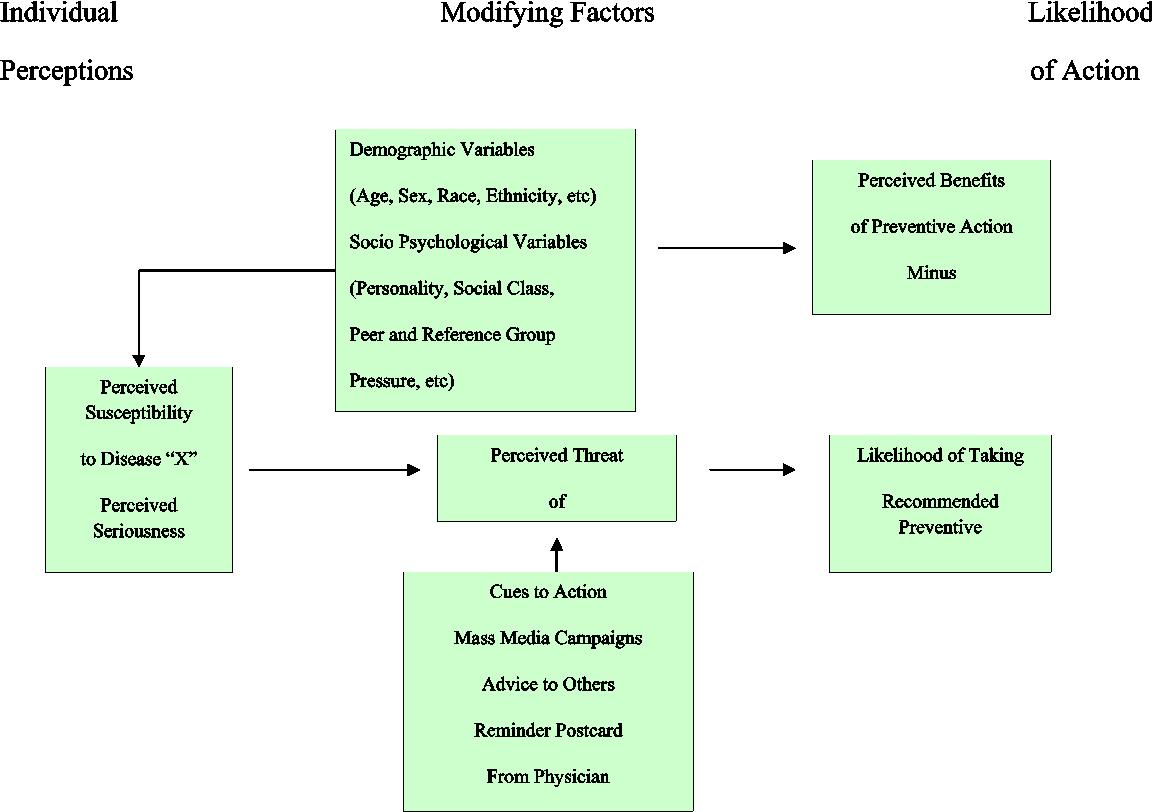Health Belief Model And Smoking Cessation
Cues to change tobacco use behavior. A woman smoker usually has an intention to quit and several factors have been perceived to be related to this action according to the Health Belief Model HBM.
Pdf Factors Associated With Relapse To Smoking Behavior Using Health Belief Model Semantic Scholar
The Health Belief Model suggests that peoples beliefs about their own.

Health belief model and smoking cessation. Effective tobacco cessation programs using advice and counselling have helped a substantial proportion of people quit smoking. According to this model the probability of quitting. Perceived severityrefers to a smok- ers belief that smoking will cause harm and bring medical and social consequences.
The Health Belief Model is a tool to formally discover a persons reasons for making a change in their behavior. The aim of the present study was to evaluate the effectiveness of tobacco cessation counselling and behavioural changes using Multi Theory Model MTM. The model continues to be used in health behavior research.
The severity of health problems from smoking cessation barriers and the benefits of quitting are ap-. This will be done by looking at the many studies supporting the model as well as the few opposing studies. In model 1 the intention to quit smoking is regressed both on health-information seeking and health belief 1 ie everything causes cancer and health belief 2 ie prevention of cancer not possible respectively.
The Health Belief Model HBM is a good model to use for smoking cessation. A recent review of HB theory models 12 pointed out similarities among. This study was conducted cross-sectionally to analyze the correlation between young adult womens intention to stop smoking with perceived factors in the construction of HBM.
A strongly related sentiment expressed by several participants was that one must believe they are ready to quit. Although initial quit rates are high among survivors with cancers strongly linked with smoking eg lung headandneck 3 many relapse and begin smoking again 4. Seriousness of tobacco as a problem.
Quitting smoking after a cancer diagnosis improves prognosis decreases mortality from cancer and decreases the risk for a second primary smokingrelated cancer 1 2. It was first developed in the 1950s by social psychologists at the US. Ad Steady nicotine release to help with smoking cravings - visit our website now.
We expected the size of the coefficient to decrease or become nonsignificant to show true mediation. It improves long-term quit rates by 11 28. Some of the immediate benefits to quit smoking include.
The HBM can be used to focus the message on overcoming the barriers to quit and the overwhelming benefits. Effectiveness of this tobacco cessation counselling needs to be evaluated. It is also might be a good predictor of safer sex by using condoms and also improved efficacy seriousness susceptibility health motivation and health knowledge by watching television motivation programmes.
The Ottawa Model for Smoking Cessation in 120 hospitals across Canada identifies the smoking status of all admitted patients followed by brief advice personalised bedside counselling timely nicotine replacement therapy andor pharmacotherapy and follow-up after discharge. As the Health Belief Model 8 the Theory of Planned Be-havior 9 and the Cognitive-Social Health Information-Processing model C-SHIP 1011. The combination of susceptibility and severity is often called perceived threat.
Ad The 4 Stages to Quit Naturally - Without anxiety weight gain or side effects. Introduction However in considering smoking cessation as a health- Since its frequent use in health-promotion researeh the related behaviour an array of variables pertinent to smok- health belief model Becker 1974 has gained considerable ing become apparent which are not readily predieted by empirical support. Blood pressure returns to normal decreased carbon monoxide levels improved respiratory function and circulation improvement.
Personal vulnerability to illness caused by tobacco use. The Health Belief Model Rosenstock 1966 is one of these models and this essay will explore how useful it can be in understanding smoking behaviour. In a review of the Health Belief Model as a means for smoking cessation such elements or personal beliefs about cessation were found to influence attitudes which in turn influenced self-efficacy eg belief of ones own ability to quit smoking towards behavior change 916.
The Health Belief Model emphasizes that tobacco use is determined by an individuals perceptions regarding. Treatment cost and effectiveness ie the benefits of taking action Barriers to quitting. Health Belief Model might me more successful in predicting addictive behaviours changes such as alcohol consumption smoking especially smokers that have cancer.
The Health Belief Model Methods For Stress Management
Pdf Factors Associated With Relapse To Smoking Behavior Using Health Belief Model Semantic Scholar
Health Belief Model An Overview Sciencedirect Topics
Health Belief Model Health Psychology Iresearchnet
Health Belief Model Examples Smoking
Chapter 3 The Health Belief Model Historical Perspectives
Health Belief Model Hbm Constructs And Related Behaviors Download Table
Https Scholarscompass Vcu Edu Cgi Viewcontent Cgi Article 5841 Context Etd
Pdf Towards An Effective Health Interventions Design An Extension Of The Health Belief Model
Self Efficacy Knowledge Health Beliefs Quality Of Life And Stigma In Relation To Osteoprotective Behaviors In Epilepsy Epilepsy Behavior
Schematic Representation Of The Health Belief Model Download Scientific Diagram
Health Belief Model Examples Smoking
Critical Elements Health Belief Model Mid Range And Borrowed Theory
The Prevention Paradox Health Knowledge



Posting Komentar untuk "Health Belief Model And Smoking Cessation"